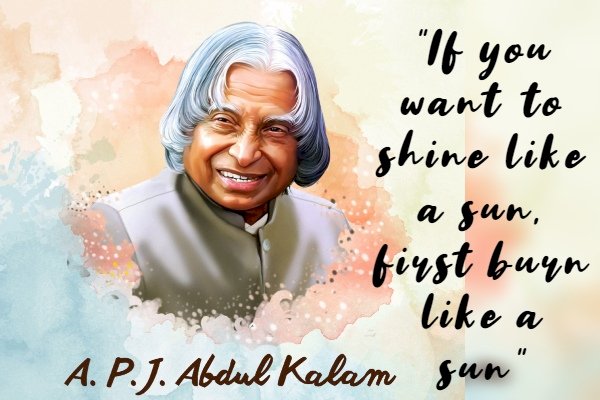APJ Abdul Kalam: Full Biography – From Inventions to Inspirational Quotes
"Read the detailed biography of Dr. APJ Abdul Kalam, the Missile Man of India. Learn about his contributions to science, presidency, vision for India, and enduring legacy that continues to inspire millions."

Biography of Dr. APJ Abdul Kalam
The Missile Man of India and the People’s President
Dr. Avul Pakir Jainulabdeen Abdul Kalam, commonly known as Dr. APJ Abdul Kalam, was one of India’s most celebrated scientists, thinkers, and visionaries. He played a pivotal role in advancing India's defense and space programs and also served as the 11th President of India from 2002 to 2007. A man of humble beginnings, Dr. Kalam rose to prominence through sheer determination, hard work, and dedication to his country.
Quick Info Section
- Full Name: Avul Pakir Jainulabdeen Abdul Kalam
- Born: October 15, 1931, Rameswaram, Tamil Nadu, India
- Nationality: Indian
- Height: 5.6 feet (167 cm)
- Died: July 27, 2015, Shillong, Meghalaya, India
- Field: Aerospace Engineering
- Notable Roles: 11th President of India (2002-2007), Renowned Scientist, Writer, Teacher
- Awards: Bharat Ratna (1997), Padma Bhushan (1981), Padma Vibhushan (1990)
- Famous Works: Leading India’s Missile Development, Vision 2020
Early Life and Education
Dr. Kalam was born in a modest Tamil Muslim family in the small town of Rameswaram, Tamil Nadu. Despite financial hardships, his family emphasized education. From a young age, Dr. Kalam was inspired by his father’s simplicity and his mother’s devotion to faith. His love for learning earned him scholarships, which allowed him to pursue his studies despite economic difficulties.
After completing his schooling in Rameswaram, Dr. Kalam graduated in Physics from St. Joseph's College, Tiruchirappalli. However, it was his passion for aeronautics that led him to the Madras Institute of Technology (MIT), where he studied aerospace engineering.
Contributions to Science and Technology
Dr. Kalam’s career as a scientist began at the Aeronautical Development Establishment of the Defense Research and Development Organization (DRDO). His big break came when he joined the Indian Space Research Organization (ISRO), where he played a pivotal role in developing the country's first Satellite Launch Vehicle (SLV-III), which successfully deployed the Rohini satellite in 1980. This achievement marked India's entry into space exploration.
The Missile Man of India
Dr. Kalam is best known for his work with India's missile programs. As the chief architect of India’s Integrated Guided Missile Development Program (IGMDP), he developed missiles like the Agni and Prithvi, earning him the title "Missile Man of India." His contributions in defense technology significantly enhanced India's strategic capabilities.
The Visionary President (2002-2007)
In 2002, Dr. Kalam was elected as the 11th President of India. His tenure was unique because of his popularity, especially among the youth, due to his approachable demeanor and vision for India’s future. He believed in the power of education and youth, and his presidency was marked by efforts to inspire the younger generation to work toward a better India.
Despite being a ceremonial role, Dr. Kalam’s presidency left a lasting impact. He remained focused on promoting India’s technological growth and self-reliance. After his tenure, he continued to serve the nation through his teachings, lectures, and writings, especially on Vision 2020, a roadmap for transforming India into a developed nation by 2020.
Awards and Honors
Dr. APJ Abdul Kalam received several prestigious awards throughout his life. In recognition of his work in science and technology, he was honored with the Padma Bhushan (1981), the Padma Vibhushan (1990), and the country’s highest civilian award, the Bharat Ratna (1997).
Books and Writings
Dr. Kalam was a prolific writer and authored several books that reflected his life philosophy, scientific achievements, and dreams for India. Some of his most popular books include:
- Wings of Fire – An autobiography that chronicles his rise from humble beginnings to becoming a leading scientist and President.
- Ignited Minds – A call to the youth of India to awaken and shape the future.
- India 2020 – A vision of a prosperous India by the year 2020.
Dr. Kalam’s Philosophy: Dream, Learn, and Serve
Dr. Kalam always emphasized the importance of dreaming big. He believed that dreams are the foundation of great achievements. His message to the youth was simple: “Dream, dream, dream. Dreams transform into thoughts, and thoughts result in action.”
He was a man who never stopped learning. Even after his presidency, he continued teaching and interacting with students across the country. Dr. Kalam’s commitment to education was evident in his role as a professor at various institutes, including IITs and IIMs.
Legacy and Impact
Dr. APJ Abdul Kalam's legacy transcends science and politics. His humility, simplicity, and dedication to the country continue to inspire millions. His vision for a developed India still resonates with young minds, motivating them to think innovatively and work hard toward building a better future.
On July 27, 2015, while delivering a lecture at the Indian Institute of Management, Shillong, Dr. Kalam collapsed and passed away due to cardiac arrest. Even in his final moments, he was engaged in his lifelong mission of sharing knowledge.
Conclusion
Dr. APJ Abdul Kalam's life is a testament to the power of dreams, hard work, and service. From launching missiles to inspiring the youth, his contributions to India are immeasurable. He will always be remembered as the People's President, a visionary who led India toward scientific excellence, and a humble soul who inspired millions to dream big.

 Deepak Maurya
Deepak Maurya 






























